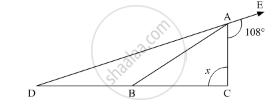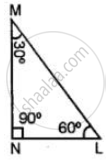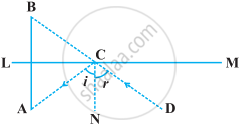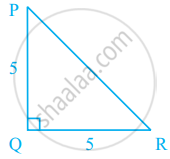Advertisements
Advertisements
प्रश्न
In a ΔABC, if ∠A = 55°, ∠B = 40°, find ∠C.
उत्तर
Given `∠ A=55^@,∠ B=40^@` then ∠ C=?
We know that
In a ABC sum of all angles of triangle is 180°
i.e, ∠ A+∠ B +∠ C =`180^@`
⇒`55^@+40^@` ∠ C `=180^@`
⇒`95^@+∠ C=180^@`
⇒`∠ C=180^@-95^@`
⇒`∠C=85^@`
APPEARS IN
संबंधित प्रश्न
Can a triangle have two acute angles?Justify your answer in case.
In the given figure, AB divides ∠DAC in the ratio 1 : 3 and AB = DB. Determine the value of x.

If the sides of a triangle are produced in order, then the sum of the three exterior angles so formed is
If two sides of a triangle are 5 cm and 1.5 cm, the length of its third side cannot be ______.
Can a triangle together have the following angles?
55°, 55° and 80°
Classify the following triangle according to angle:

One of the angles of a triangle is 65°. If the difference of the other two angles is 45°, then the two angles are
The image of an object placed at a point A before a plane mirror LM is seen at the point B by an observer at D as shown in the following figure. Prove that the image is as far behind the mirror as the object is in front of the mirror.
[Hint: CN is normal to the mirror. Also, angle of incidence = angle of reflection].

In figure, PQ ⊥ RQ, PQ = 5 cm and QR = 5 cm. Then ∆PQR is ______.
Can we have two acute angles whose sum is an obtuse angle? Why or why not?
